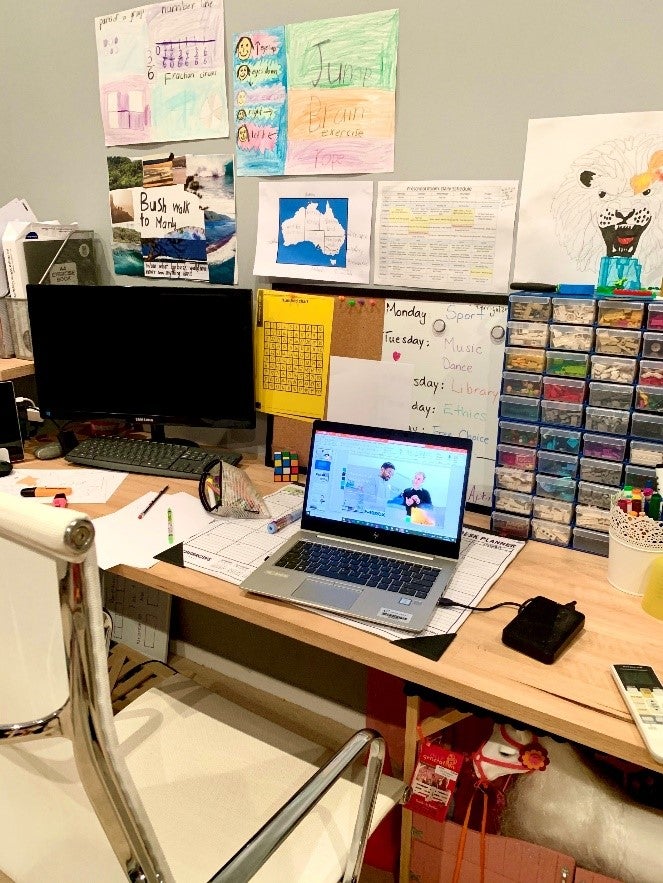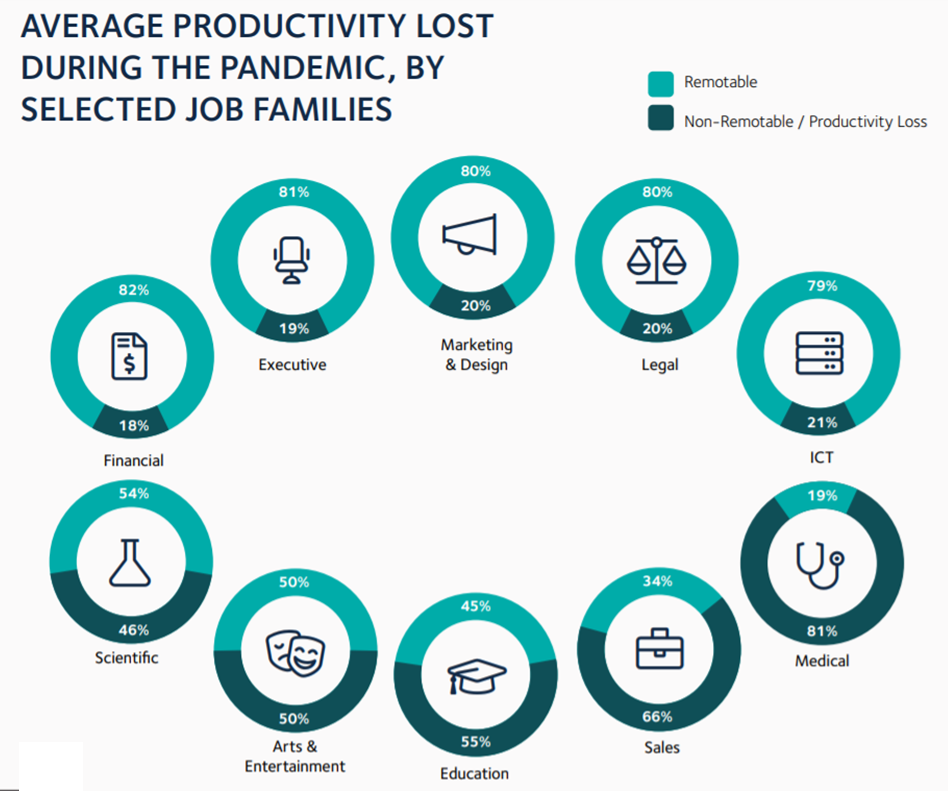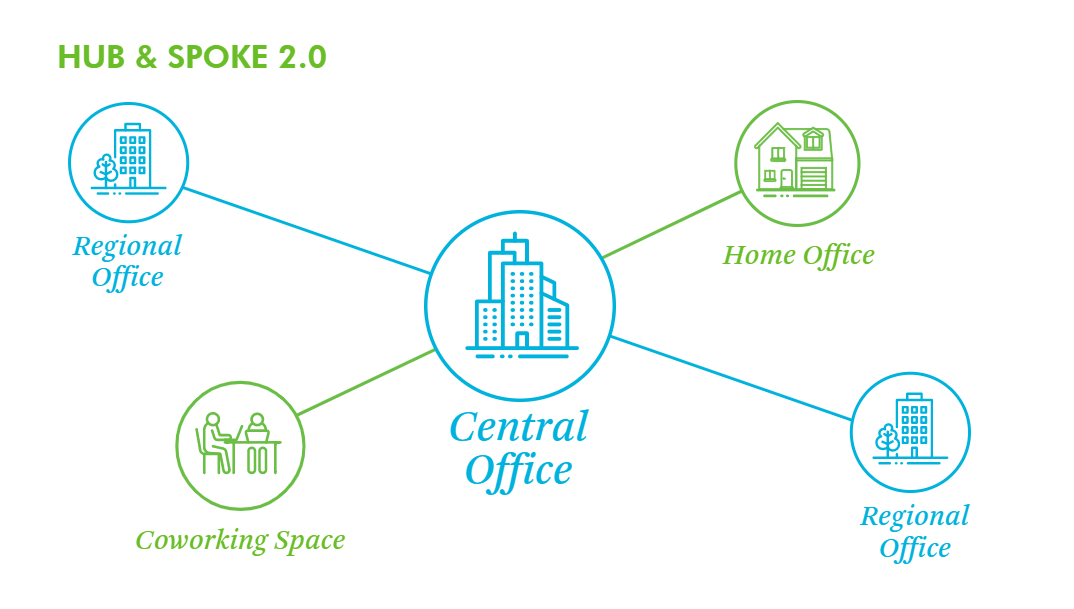At the start of the pandemic, millions of Australians pivoted to remote work in a matter of weeks as an unprecedented set of measures restricting mobility was put in place to flatten the curve. While increased flexibility and productivity have been positive outcomes from the shift to remote work over the past seven months, organizations are now grappling with what to make of the new ways of working and how to sustainably drive change over the long term.
During the shutdown, this is where I worked every day of the week. I shared the space with my daughter who is in primary school (that is her geography assignment hanging proudly above my laptop). My husband, who works for a major bank, also worked from home during this period. We rotated through this space as we supported our daughter through her first experience at online learning while balancing full-time jobs.

In my line of work, meeting with clients is core to my job. The agenda for most client meetings I conducted via video conference during the shutdown began with getting acquainted with each other’s kids, pets, and favorite books (all of which could be seen on the video) and placing bets on how often we expected to be interrupted during the video conference. Many who have recently returned to the office a few days a week look back on the early days of the pandemic with relief that “we’ve made it.” But this is not a sprint — it’s an ultramarathon where the finish line is not yet fully known.
Without warning, preparation, planning, or design nearly 88 percent of business organizations globally mandated or encouraged their employees to work from home at the start of the pandemic. Initiatives that normally take five or more years aimed at changing ways of working, digitization, reskilling, innovating business models, and transforming the company culture were compressed into a few short months. In other words, many organizations started the ultramarathon at a pace that is not sustainable nor healthy.
On Oct. 7, 2020, the World Health Organization announced that “many countries have been reporting an increase in ‘pandemic fatigue’ — people are feeling demotivated about following recommended behaviors to protect themselves and others from the virus.” This comes at a time when organizations worldwide are focused on returning to the office in an effort to stimulate the economy and support workers who are experiencing burnout and mental health issues associated with prolonged periods of remote work and feelings of isolation. The speed and scale of change that we have experienced over the last few months have caused a shift in the nature of work. But surely this cannot be the best of what the future of work has to offer?
Understanding the impact of COVID-19 on the future of work through three lenses
Organizations are beginning to settle in for the long haul with expectations that returning to “normalcy” may not happen until early 2022. The “experimentation” phase that many organizations found themselves thrust into at the start of the pandemic is starting to yield discoveries and learnings about the future of work that will set the table for driving sustainable and pragmatic change.
Korn Ferry defines the future of work as a series of choices that organizations and teams make to operate effectively and sustainably in the new world of work. Over the past two decades, the dominant headlines about the future of work involved technological advances (automation, artificial intelligence (AI), robotics), shifts in demographics (ageing population, rise of the millennials), environmental challenges (climate change and the role of industries and society), and regulatory and geopolitical change. Given the spectrum of possibilities, it is important to focus on how to make choices about what the future of work means for your workforce and your organization’s mission or purpose. The future of work is, after all, human. We recommend considering your choices using the following three lenses:
- Work: what work will get done and how
- Place: where work happens
- Workforce: who will do the work
This article examines key future of work trends that have been accelerated by COVID-19 across the dimensions of work, place, and workforce and the actions organizations are taking to make the future of work “work” for them.
1. Remotability of job roles – redesigning what work will get done and how
The acceleration of digitization and the automation of work will continue to gather steam throughout the pandemic and beyond. According to the Future of Jobs Report from the World Economic Forum, 84 percent of global businesses have accelerated the use of digital tools and video conferencing to enable remote work, and 50 percent have accelerated the automation of tasks. The need for organizations to optimize costs in the face of declining revenue and uncertain growth prospects has created a burning platform to complete transformation projects in months rather than years.
Lessons learned from the early days of the pandemic suggest that it is time to pause and zoom out to understand how we can make the future of work work for everyone in a healthy and sustainable way. When organizations transitioned their workforce to remote work in a matter of days, there was little to no time to redesign roles, understand what work could be done remotely, and develop a full appreciation of the impact of remote work on teams and individuals. In the medium term, organizations will likely devote more resources and time toward understanding what jobs can be done remotely by exploring which tasks or activities could be delivered effectively from anywhere, which tasks could be automated, and which tasks require in-person or onsite delivery to execute the task (think customer-facing activities, complex projects that require a high level of collaboration, or activities that depend on others who cannot work remotely). While organizations are turning their attention to returning to the office, improving the productivity of remote work will be an enduring trend in the post-pandemic world.
Organizations and governments have already begun the process. For example, a large Australian financial services company has been using big data and AI to begin mapping their teams and organization’s jobs into tasks to understand the impact of remotability on different job families. Restructuring and planning activities are based on predictive models that enable the organization to understand which roles require redesigning to improve productivity. Redesigning the role may involve augmenting the role with digital tools or identifying tasks that must be done onsite. Tasks that require individuals to be on site can be scheduled and rostered appropriately to enable social distancing. Lastly, the organization is using the output from the remotability modelling as an input to their talent strategy as they plan to offer reskilling and upskilling to workers aligned to building the necessary skills and capabilities for identified ‘future-ready roles’. To further illustrate the impact of quantifying remotability by job family, see Figure 1. Produced by Faethm, an AI and augmented analytics platform, the analysis indicates the level of remotability by job family based on the billions of workforce data that the Faethm AI engine is trained on. Korn Ferry has been exploring opportunities with Faethm to help organizations chart their course back to growth with greater precision and predictability using big data, AI, and success profiles. For example, Figure 1 indicates that 80 percent of the activities that are delivered by roles in the legal job family could be performed remotely while 20 percent of the activities are non-remotable. This suggests that when periods of remote work may be necessary to support social distancing and restrictions of movement during the pandemic period, there is a potential 20 percent hit to productivity due to the nature of the activities that cannot be delivered remotely. The implication of this data does not mean the solution is to make all activities in the legal job family 100 percent remotable. Rather, the insight regarding the remotability of legal roles enables broader questions about how the 20 percent of non-remotable work gets done today and what could be reimagined to further augment workers with digital tools.

In summary, organizations and leaders will benefit from taking a data-driven view on how work has changed at the activity/role level because remote working, with all of the various shapes that it could take, is here to stay. A total of 75 percent of Australians surveyed believe that post-COVID-19 their employers are more likely to support working from home than they did before the pandemic. The automation and digitization of work is not slowing down. In fact, it has accelerated at an unprecedented rate. It is crucial for organizations to take deliberate steps to reimagine how work could be performed in the new world to provide meaningful roles for workers that increase engagement, offer flexibility, and support mental health and well-being.
2. Return to the "office" - the changing role of the workplace
Organizations are increasingly turning their attention to returning to the office. Recent surveys point to a higher number of workers who want to return to the office compared to six months ago. Overwhelmingly, most workers simply want the option for flexibility. Offering flexible work options was a powerful trend before COVID-19 and now, the role and purpose of the workplace faces a defining moment as the scale of change the world has experienced over the past several months necessitates greater personalization of “place” in the future of work.
Organizations and leaders should align the role of the “workplace” to the changing nature of work and the needs of the workforce rather than snapping back to pre-COVID-19 one-size-fits-all ways of working. The implications of ignoring the needs of the workforce could result in an unwanted backlash by employees. In a Sydney Morning Herald interview conducted on Oct. 26, 2020, Professor Rae Cooper, an employment relations expert at Sydney University’s Business School, stated that she expects many employees will push back against a full-time return to the office after demonstrating their productivity while working from home. "I think the rebellion will happen if there is no accommodation of the needs of people for flexibility," Professor Cooper said. To further reinforce Professor Cooper’s comments, the Australian Bureau of Statistics conducted its monthly survey of households in September 2020 and showed that one-third of the Australian working population worked most days at home in September despite restrictions having been lifted in most states.
The future of the workplace must embrace flexibility and a changing world so that when teams need to come together in the office, they flock to the office because the design of the space enhances productivity, supports multiple styles and ways of working, and is equipped with the right tools and technology. Increasingly, organizations such as Deloitte and PWC are investigating the use of the “hub and spoke” model. For years, organizations have made use of a central office location in the CBD connected to satellite offices in other major cities or states. Because of the pandemic, the hub and spoke model is undergoing an upgrade according to David Cairns, Senior Vice President, CBRE Canada. Cairns sees a future where hub and spoke 2.0 (see Figure 2) features satellite offices near where workers live. The satellite offices could be offerings such as street-front level or neighborhood-centric flexible space that is bookable by the minute. According to Cairns, “This is space where people can have meetings, collaborate, and just get out of the house and into an office environment.

It’s for people like me who don’t want to go all the way down to a downtown office most of the time.” It could also be a place to meet customers where they are, which can be difficult to accommodate using a centralized downtown office.
In summary, organizations and leaders should avoid the trap of designing a one-size-fits-all solution for the return to the office. Now is the time to put the employee experience at the heart of workplace design. Aligning workspace design and purpose to the changing nature of work and the needs of the workforce is a call to action to avoid a backlash from employees who are looking for flexibility and an improved work-life balance.
Now is the time to put the employee experience at the heart of workplace design.
3. Reimagining organizational and team structures – enabling the inclusive, future-ready workforce
The future-ready workforce is connected to the work through shared purpose and engagement with others to deliver outcomes from anywhere.
What we have learned thus far from the pandemic is that it has resulted in a seismic shift towards the future of work. At the same time, the pandemic has amplified the barriers and challenges that existed pre-COVID-19 where, in some cases, the disproportional impact of COVID-19 threatens to push society and businesses backwards.
For example, the pandemic has disproportionately impacted women and minority groups worldwide. Last month alone, nearly 900,000 women reported being unemployed, a stunning four times the number of men who were without work according to a Korn Ferry study. That goes against a historical trend where men disproportionately lost jobs during economic fallouts, and suggests the pandemic not only threatens the progress women have made in the workplace — but it also disrupts the pipelines that firms were building for future female leadership talent. “It has the potential to be a total wipeout,” says Jane Stevenson, Korn Ferry’s global leader for CEO succession and vice chairman of the firm’s board and CEO services practice. With the financial impact of the pandemic likely to bleed at least into next year and possibly longer, Stevenson says more women are going to leave the workforce before they start coming back — if they do at all. “This trend isn’t done yet.”
Reimagining how organizations and teams come together aligned to new ways of working and equitable access to workplaces and support is a recipe for success that existed well before COVID-19. Executing the strategy will be critical in the post-pandemic world. Leaders play a critical role in driving the culture change that will help organizations see their way through to the future of work.
We live in a time of volatility, complexity, and transition, and it is here to stay. As Canadian Prime Minister Justin Trudeau stated during his 2018 address in Davos, “The pace of change has never been this fast, yet it will never be this slow again. There's enormous opportunity, and enormous potential, in that realization.” Organizations that lead, rather than resist, the shift to the future work must begin to take deliberate steps to lean-in to a new definition of job roles and careers, embrace new ways of working supported by the workplace, and drive a culture of continuous learning and inclusive leadership.




